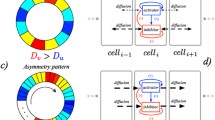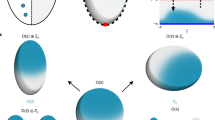Abstract
We review the mathematical formalism underlying the modelling of stochasticity in biological systems. Beginning with a description of the system in terms of its basic constituents, we derive the mesoscopic equations governing the dynamics which generalise the more familiar macroscopic equations. We apply this formalism to the analysis of two specific noise-induced phenomena observed in biologically inspired models. In the first example, we show how the stochastic amplification of a Turing instability gives rise to spatial and temporal patterns which may be understood within the linear noise approximation. The second example concerns the spontaneous emergence of cell polarity, where we make analytic progress by exploiting a separation of time-scales.






Similar content being viewed by others
References
Altschuler, S. J., Angenent, S. B., Wang, Y., & Wu, L. F. (2008). On the spontaneous emergence of cell polarity. Nature, 454, 886–889.
Biancalani, T., Fanelli, D., & Di Patti, F. (2010). Stochastic Turing patterns in the Brusselator model. Phys. Rev. E, 81, 046215. doi:10.1103/PhysRevE.81.046215.
Biancalani, T., Galla, T., & McKane, A. J. (2011). Stochastic waves in a Brusselator model with nonlocal interaction. Phys. Rev. E, 84, 026201. doi:10.1103/PhysRevE.84.026201.
Biancalani, T., Rogers, T., & McKane, A. J. (2012). Noise-induced metastability in biochemical networks. Phys. Rev. E, 86, 010106(R). doi:10.1103/PhysRevE.86.010106.
Black, A. J., & McKane, A. J. (2012). Stochastic formulation of ecological models and their applications. Trends Ecol. Evol., 27, 337–345. doi:10.1016/j.tree.2012.01.014.
Boland, R. P., Galla, T., & McKane, A. J. (2009). Limit cycles, complex Floquet multipliers and intrinsic noise. Phys. Rev. E, 79, 051131.
Bonachela, J. A., Munoz, M. A., & Levin, S. A. (2012). Patchiness and demographic noise in three ecological examples. J. Stat. Phys., 148, 723–739.
Bromwich, T. (1926). An introduction to the theory of infinite series. London: Chelsea.
Butler, T. C., & Goldenfeld, N. (2009). Robust ecological pattern formation induced by demographic noise. Phys. Rev. E, 80, 030902(R). doi:10.1103/PhysRevE.80.030902.
Butler, T. C., & Goldenfeld, N. (2011). Fluctuation-driven Turing patterns. Phys. Rev. E, 84, 011112. doi:10.1103/PhysRevE.84.011112.
Butler, T. C., Benayounc, M., Wallace, E., van Drongelenc, W., Goldenfeld, N., & Cowane, J. (2012). Evolutionary constraints on visual cortex architecture from the dynamics of hallucinations. Proc. Natl. Acad. Sci. USA, 109, 606–609. doi:10.1073/pnas.1118672109.
Chaikin, P. M., & Lubensky, T. C. (2000). Principles of condensed matter physics (3rd ed.). Cambridge: Cambridge University Press.
Cross, M. C., & Greenside, H. S. (2009). Pattern formation and dynamics in non-equilibrium systems. Cambridge: Cambridge University Press.
Datta, S., Delius, G. W., & Law, R. (2010). A jump-growth model for predator-prey dynamics: derivation and application to marine ecosystems. Bull. Math. Biol., 72, 1361–1382. doi:10.1007/s11538-009-9496-5.
Gardiner, C. W. (2009). Handbook of stochastic methods for physics, chemistry and the natural sciences (4th ed.). Berlin: Springer.
Gillespie, D. T. (1976). A general method for numerically simulating the stochastic time evolution of coupled chemical reactions. J. Comput. Phys., 22, 403–434.
Gillespie, D. T. (1977). Exact stochastic simulation of coupled chemical reactions. J. Phys. Chem., 81, 2340–2361.
Glansdorff, P., & Prigogine, I. (1971). Thermodynamic theory of structure, stability and fluctuations. Chichester: Wiley-Interscience.
Gupta, A. (2012). Stochastic model for cell polarity. Ann. Appl. Probab., 22, 827–859.
Lawson, M. J., Drawert, B., Khammash, M., Petzold, L., & Yi, T. M. (2012, submitted). Spatial stochastic dynamics enable robust cell polarization.
Lugo, C. A., & McKane, A. J. (2008). Quasi-cycles in a spatial predator-prey model. Phys. Rev. E, 78, 051911.
Mehta, M. L. (1989). Matrix theory. India: Hindustan Publishing Corporation.
Murray, J. D. (2008). Mathematical biology, Vol. II (3rd ed.). Berlin: Springer.
Ridolfi, L., Camporeale, C., D’Odorico, P., & Laio, F. (2011a). Transient growth induces unexpected deterministic spatial patterns in the Turing process. Europhys. Lett., 95, 18003. doi:10.1209/0295-5075/95/18003.
Ridolfi, L., D’Odorico, P., & Laio, F. (2011b). Noise-induced phenomena in the environmental sciences. Cambridge: Cambridge University Press.
Risken, H. (1989). The Fokker–Planck equation—methods of solution and applications (2nd ed.). Berlin: Springer.
Rogers, T., McKane, A. J., & Rossberg, A. G. (2012a). Demographic noise can lead to the spontaneous formation of species. Europhys. Lett., 97, 40008. doi:10.1209/0295-5075/97/40008.
Rogers, T., McKane, A. J., & Rossberg, A. G. (2012b). Spontaneous genetic clustering in populations of competing organisms. Phys. Biol., 9, 066002.
Scott, M., Poulin, F. J., & Tang, H. (2011). Approximating intrinsic noise in continuous multispecies models. Proc. R. Soc. Lond. A, 467, 718–737. doi:10.1098/rspa.2010.0275.
Turing, A. M. (1952). The chemical basis of morphogenesis. Philos. Trans. R. Soc. Lond. B, 237, 37–72. doi:10.1098/rstb.1952.0012.
Van Kampen, N. G. (2007). Stochastic processes in physics and chemistry (3rd ed.). Amsterdam: Elsevier Science.
Wiggins, S. (2003). Introduction to applied nonlinear dynamical systems and chaos (2nd ed.). Berlin: Springer.
Woolley, T. E., Baker, R. E., Gaffney, E. A., & Maini, P. K. (2011). Stochastic reaction and diffusion on growing domains: understanding the breakdown of robust pattern formation. Phys. Rev. E, 84, 046216. doi:10.1103/PhysRevE.84.046216.
Acknowledgements
This work was supported in part under EPSRC Grant No. EP/H02171X/1 (A.J.M. and T.R.). T.B. also wishes to thank the EPSRC for partial support.
Author information
Authors and Affiliations
Corresponding author
Rights and permissions
About this article
Cite this article
McKane, A.J., Biancalani, T. & Rogers, T. Stochastic Pattern Formation and Spontaneous Polarisation: The Linear Noise Approximation and Beyond. Bull Math Biol 76, 895–921 (2014). https://doi.org/10.1007/s11538-013-9827-4
Received:
Accepted:
Published:
Issue Date:
DOI: https://doi.org/10.1007/s11538-013-9827-4




